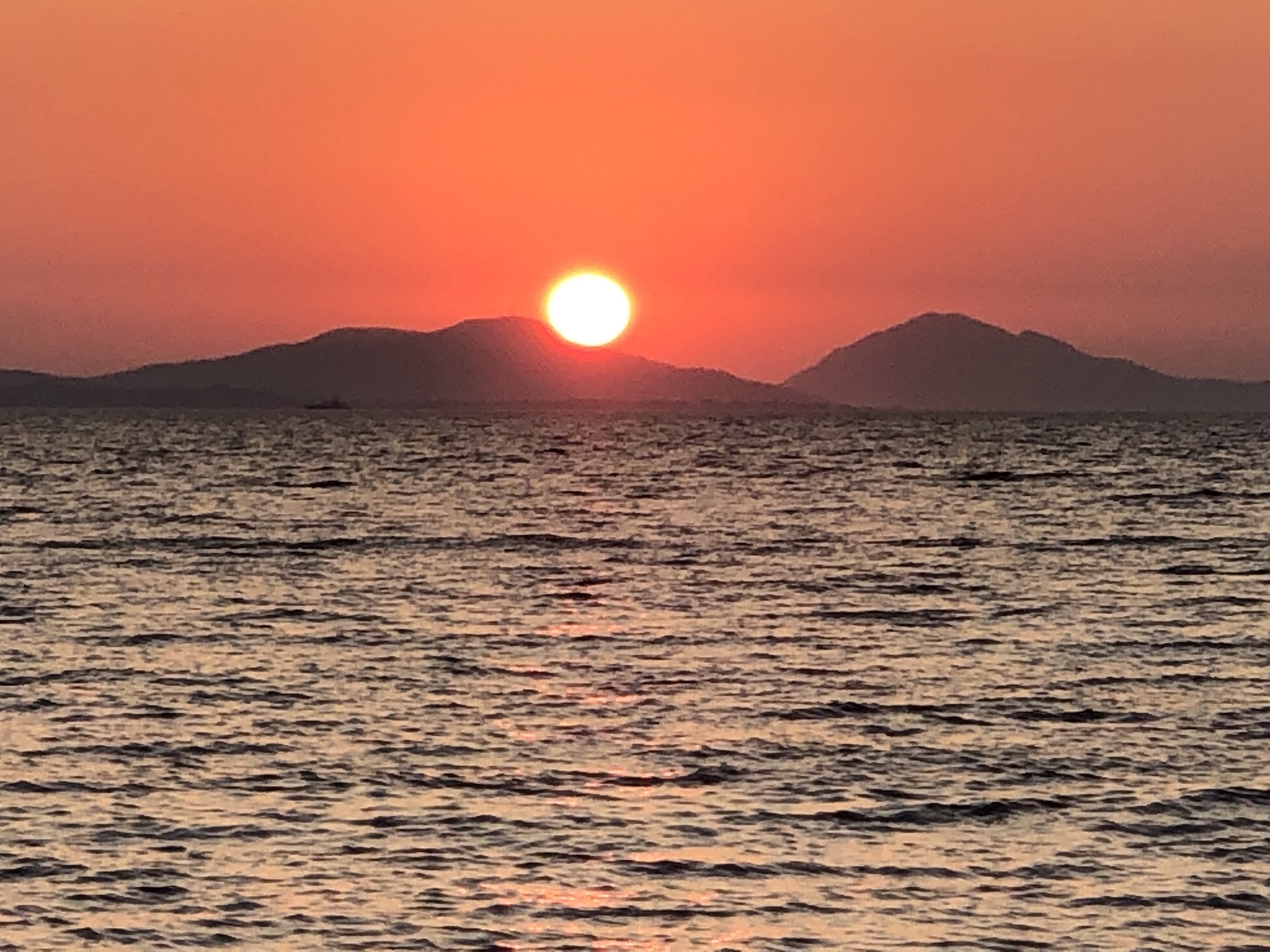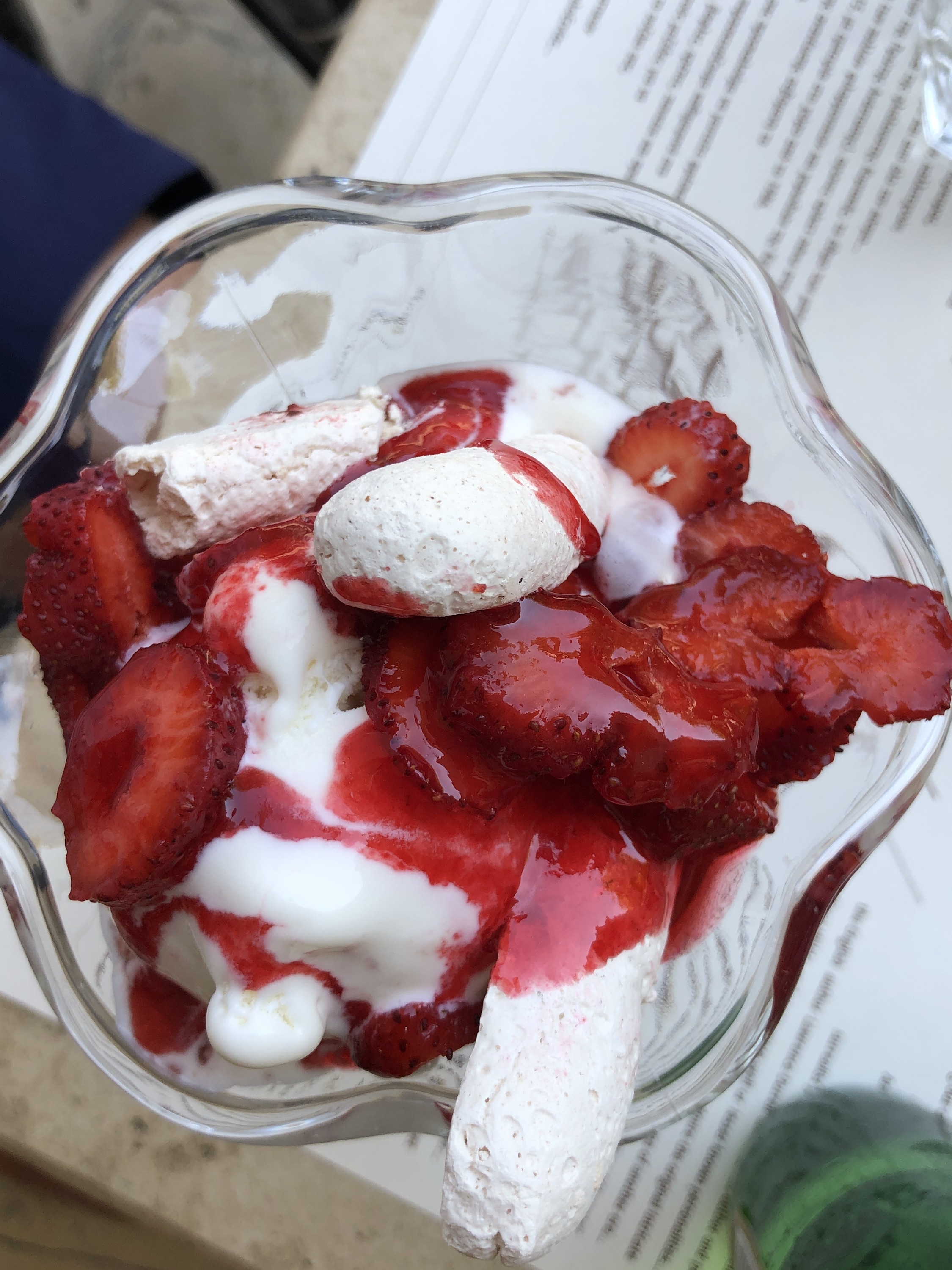Looking at the overall weather pattern for the next 10 days, getting to Italy doesn’t seem to be much of a problem. But going beyond Salento to the west is not looking good. There are three bodies of water we have to cross, each of which is showing stormy weather at annoyingly frequent intervals over that period. This means that everything would have to go just right to get to Sicily and back in the time we have available. “Plan for the worst and hope for the best” is our usual maxim, so reluctantly we have to give up on seeing Sicily and our friends Morella and Luigi this year. We’ll have to catch up next year.
So the morning after the Sardine Festival we head off back northwards to Corfu to take advantage of, what looks to be, a pretty large weather window to cross back to Italy. But heading north from Preveza to Corfu can be an onerous undertaking. The winds typically blow from the northwest (the direction we want to go) and there is usually a swell from the same which has had the whole length of the Adriatic to gather strength. Fortunately the island of Corfu provides some shelter from the swell - but it still can be a bumpy and slow ride.
When we come out of the Preveza channel there is, unusually, a wind blowing from the east. It’s not particularly strong but it provides us with enough forward motion to be able to switch the engine off and sail in peace. Usually (because of the aforesaid hard work) we don’t have much time or inclination to appreciate this part of the Greek coastline. But today we can. It is quite lovely - a mixture of hill farms, olive groves and beach towns all with a background of rugged mountains. I am guessing that this is a part of Greece that only the Greeks know about - the logistics of getting here would make it difficult for the average sun-seeking tourist.
The wind finally dies and we are resigned to motoring but the sea is calm with no swell so the passage is at least comfortable.
The forecast is for the normal wind pattern to start early in the afternoon but today it is earlier still. We only have to motor for less than an hour until the wind starts to pick up from the northwest. We are not pressed for time, so we can afford to take big wide tacks to head us zig-zag towards our destination.
The wind is forecast to grow in strength as the afternoon progresses - and it does. Soon we have a steady twelve knots and we continue to tack, this time more speedily, towards our evening goal. About two hours out from our destination we have steady winds of 18 knots with stronger gusts. The sea has picked up a bit too. True Colors is zipping along between 7 and 8 knots.
The fun thing about sailing like this is that when you get to your destination you have to stop - quickly but in a controlled fashion (you hope). So we scream into our bay, swing True Colors round into the wind, and drop her sails in a fairly professional manner. The bay is one we have stayed in before and there is plenty of room for us to park. The bay protects us from the wind and only a small amount of swell bobs the boats up and down in the early evening.
The wind is forecast to die completely in the evening. It doesn’t ; it strengthens and swings round to the north-east. The increased strength is annoying but the good news is that this bay offers near perfect protect from winds from this direction. (Of course I planned that.). The night is a bit more energetic than we expect as the wind keeps blowing all the way through.
The next day we head less than 20 milies north to Mourtos-Syvota. This is a popular anchorage that is a bit open to the prevailing winds. This makes good holding for the anchor a prime objective. We have found the holding here to be a little suspect and don’t really want to wake up in the night finding ourselves es dragging our anchor all the way onto the town quay.
Earlier in the season, discretion was the better part of valor and we left rather than trust the suspect holding. But this time we are determined to do better. Our first couple of attempts produced the same insecure result but the third time was the charm. We got the anchor firmly dug in to a nice patch of sand and it wouldn’t budge even when we put the engine in reverse at 1600 revs (our final test).
We marvel at folks who pick a spot, throw the anchor over the side, check that it hit the bottom and call it good without ever testing just how secure they are. Even if you don’t do this yourself, you have to worry about boats near you that adopt this approach.
But the anchorage here is very picturesque with a view over to Corfu that is particularly attractive at sunset. We like it so much (and and are sufficiently proud of our anchoring) that we spend two peaceful nights here.
Our last leg is on to Corfu.
The weather is calm - water-skiing anyone? And we motor to the marina at Gouvia outside Corfu town.
We take the opportunity to do some sightseeing in the town and some re-provisioning for the next few days. The relative sophistication and cosmopolitan nature of Corfu makes a pleasant change from the more simple delights of Ionian cruising.
There are some good shops and a flourishing cafe society which provides a great opportunity for people watching and ice cream.
What’s Greek for “Banksy”?
Gouvia is really the best (largely because it’s the only) marina for making a short crossing back to Italy, but the logistics are more than a little stressful. To check out of the country we have to visit the Port Police and the Customs - the Port Police is in the marina; the Customs is in the Ferry Terminal a cab ride away. The Port Police is nearly always busy and can mean a wait of multiple hours. But today the line is relatively short and the policeman is friendly. He queries why we would want to leave his lovely country just to go to Italy. He also lets us know that he has visited Boston (where True Colors is registered) and he liked it. But he complains that he couldn’t get used to going to bed so early - people in Greece eat late not starting until 9:00 or 10:00pm and not finishing until after midnight. We can see how New England might be a bit of a shock. He clearly believes the USA is under-sophisticated.
The Customs (20 minutes away) is in the same place as they handle ferry passengers to Albania and they give the impression that they find dealing with private yachts a serious imposition and don’t have any apparent system in place to do so. This translates into more hours waiting in total uncertainty.
During this “process”, Lori strikes up a conversation with a nice lady from Serbia who is waiting for the Albanian ferry (which is late and no-one has any information about what to expect). She says things like this don’t happen in Serbia any more; things are efficient, customer-friendly and service-oriented. She says Greece really needs to get with the program and she is right. Some people are preferring Albania as a tourist destination compared to Greece. Remember not so long ago Albania was known as the “Cuba of the Mediterranean” (and it wasn’t because of the coffee or the music).
When we finally penetrate the inner sanctum of the Customs office, the officer is not friendly but also not particularly interested. It is important to take a deep breath and persevere. And eventually, dismissively we get all the paperwork done and finally we are “free to go”- interesting phrase and a very different perspective from that of the Port policeman.
We have made the crossing to Italy overnight on most of our previous trips but this time we plan to break the journey at a group of Greek islands that lie off the northwest coast of Corfu. This means that an 80-mile trip splits into a 30-mile trip and a 50-mile trip - each of which can be done in a day.
These islands, called the Diapontians, The total population of the three islands in the group is just about 1200 - so you must have to REALLY like your neighbors. During the second millennium, largely due to their proximity to the strategically important Corfu, they were the site of numerous sea battles in the struggle for control of the sea trading routes. Today they are pretty sleepy and are focused mainly on very low-key tourism and, therefore, a very different proposition than the mass tourism of Corfu.
We spend a pleasant night anchored in a large bay on the south of the island and, the next day, head across another totally calm sea to make landfall in Santa Maria di Leuca on the very tip of the “heel” of Italy.
Courtesy flag changing ceremony
Lori celebrates returning to Italy by ordering pizza for dinner.









